|
19-12-2023
-------------------------------------------
Navigation
Previous / Home / Heading / Next
-------------------------------------------
https://www.habiter-autrement.org/ > Sites-Education
--------------------------------------
Communication non verbale
Nonverbal Communication
- meeting
Hand signals / Les signes avec les mains
Source:
https://communitytortuga.wordpress.com/hand-signals/
Hand signals offer a nonverbal communication, that can take place at
the same time as verbal communication without disturbing the latter.
Everyone who’s not talking at the moment can express their opinions
and needs or can moderate the talk. Hand signals therefore
facilitate communication in bigger groups, sensible process and
prevents disturbances. They’re also useful for moderation, because
they show the mood of the group and because the whole group can
moderate in the background.
But we don’t just find them useful, but also protective. Many people
don’t like to talk in front of groups. If you’re also potentially
confronted with boos and jeers or bored yawns, is much less likely
to dare to rise to speak. By the use of exactly these hand signals
in exactly this meaning we want to contribute to a respectful and
considerate interaction with each other.
Many of us already know this kind of nonverbal communication. In
order not to lead to confusion and misunderstandings we want to use
the same hand signals with the same meanings.
The following hand signals have been developed by others and
ourselves. We’ve used them in real live and found them quite helpful:
------------------------------------------------------------------------
Direct Reply /
réponse directe /
direkte Antwort
Put both your hands up / point with both your hands at the person
you have a direct answer to.
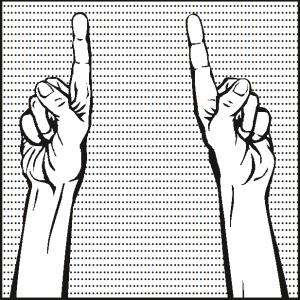
If someone has a Direct Reply the will be the next in line to talk,
so that a question can be answered directly. This hand signal shall
not be misused to give your own statement or proposal for solution.
It’s supposed to only give room to give the group an important
informatioin or speed up the process by giving a short information.
------------------------------------------------------------------------
Agreement / Accord /
Zustimmung
Wave with both your hands above or next to your head.
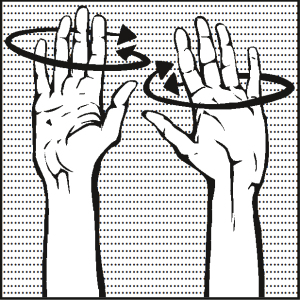
With this hand signal you can show your agreement to an opinion or
statement without having to interrupt the talking person, repeat
what was said before or tell everyone verbally that you agree. This
way the group as well as the moderation constantly get feedback. We
also need fewer time, because not everyone who has the same idea or
solution proposal has to speak out loudly. Note: This is only
feedback! Even if a lot of people or seemingly everyone’s waving
their hands does not mean that we’ve found a consensus. A consensus
has to be verbally (or in writing) confirmed by everyone!
------------------------------------------------------------------------
Disagreement / Désaccord /
Ablehnung
Wave your hands lower, next to your stomach (but high enough so we
can see them, even if we’re sitting at a table).

This hand signal shows disagreement towards an idea or solution for
proposal. Like with the above you don’t need to speak up to give
your opinion and group as well as moderation get a constant
feedback.
------------------------------------------------------------------------
Louder
/ Plus fort /
lauter
Move both your hands up in front of your body, palms up.
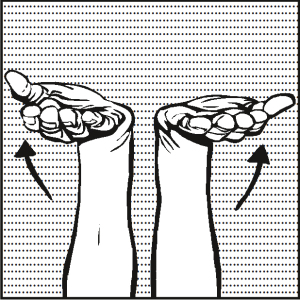
This hand signal shows the currently speaking person that they need
to speak louder. This hand signal can and should be mirrored by
other people, so that it can be seen more quickly by whoever’s
talking at the moment.
------------------------------------------------------------------------
Stay cool / relaxe /
cool bleiben
Move both your hands down in front of your body, palms downwards.

With this hand signal you can say two things: You can tell the
talking person, that he or she is talking to quickly. In a fierce,
emotional, angry situation you can tell people: Stay calm, calm
down, be fair, be objective, let’s stay constructive.
------------------------------------------------------------------------
Language / Traduction /
Übersetzung
With your index finger and thumb form an L (for Language).
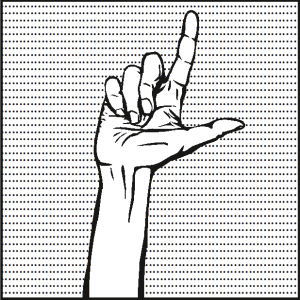
This hand signal doesn’t have to be used only in multilingual
situations. If someone shows it everyone should wait and ask what’s
going on. It can mean:
I need translation.
I need more time for translation.
I don’t understand your language (technical language, terminology),
please use a simpler language.
Please use a less discriminating language.
I didn’t understand a word / some words. Please tell me / us what
they mean.
------------------------------------------------------------------------
I understand you / We’re going in circles / Je t'ai
compris /
ich habe bereits verstanden
Both hands circle around each other.
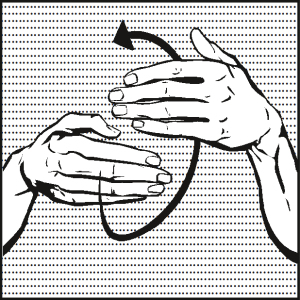
This hand signal is supposed to give a positive feedback to the
speaking person: I understand what you’re saying. As we know it from
our everyday lives we might feel attacked, but we want to work on
only using and interpreting this signal only in this sense. It’s not
supposed to criticise what someone said.
It can also tell the group or moderation: We’re going in circles.
Sometimes the process is dragging and we don’t get off the spot, in
spite of people rising to speak. If the sign is shown like that the
group / moderation should think about taking a break or how to
change the process.
------------------------------------------------------------------------
Technical Point
-
Timeout /
Point technique- le temps dépassé/
technischer Punkt
Make a T with both your hands.
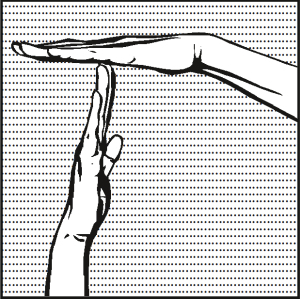
This handsignal will always interrupt the current speaker’s list and
can even interrupt the speaking person (if possible not in the
middle of the sentence). It’s not supposed to be misused to bring
your own statements or opinions, but only to be used in emergencies
or if there is a rational reason that should stop the discussion:
I have important organisational information for the group (dinner’s
ready, it started to rain and our stuff is still outside)
Emergencies (Fire!)
I really nead a break. I don’t feel so good. (In this case of course
you let the current speaker finish their statement)
------------------------------------------------------------------------
Proposal for Process / Je propose une autre voie /
Prozessvorschlag
Form a P with both your hands (Proposal).
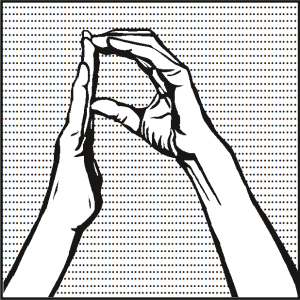
If the discussion or the decision making process is dragging, going
in circles or generally not going anywhere you can show that you
have a proposal how we can continue in another way. This sign will
also interrupt the line of speakers but shouldn’t interrupt the
current speaker.
------------------------------------------------------------------------
Focus / Recentrage /
Fokus-SW
Put both your hands on the sides of your face (like blinkers). Now
either look at the currently speaking person or around the room (depending
on who you mean).
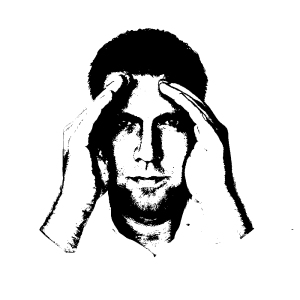
This hand signal can show the currently speaking person that he /
she lost focus and you’d like him / her to get back on track. You
can also show this sign to the whole group to tell everyone: We’ve
lost focus, we meant to speak about something else, let’s get back
to our topic.
------------------------------------------------------------------------
List of speakers :
Instead of raising one hand / finger you show as many fingers as
your place in the list of speakers would be.
------------------------------------------------------------------------
By this means of self-moderation / group-lead list of speakers the
task of keeping track of who’s next does not have to be fulfilled by
the moderation, which is really great if there is non. Everyone who
wants to say something communicates by eye contact with the others
to determine where they are in the list. If possible people who
speak a lot should let others who haven’t said so much yet go first.
----------------------------
Non-Verbal Communication : Interpersonal communication is
much more than the explicit meaning of words, the information or
message conveyed. It also includes implicit messages, whether
intentional or not, which are expressed through non-verbal
behaviours. Non-verbal communications include facial expressions,
the tone and pitch of the voice, gestures displayed through body
language (kinesics) and the physical distance between the
http://www.skillsyouneed.com/ips/nonverbal-communication.html
La communication non verbale (ou langage du corps) désigne
dans une conversation tout échange n'ayant pas recours à la parole.
Elle ne repose pas sur les mots, mais sur les gestes (actions et
réactions), les attitudes, les expressions faciales (dont les
micro-expressions) ainsi que d'autres signaux, conscients ou
inconscients, tels que les odeurs. La communication non verbale
s'intéresse aussi à l'environnement, c'est-à-dire le lieu dans
lequel les interactions ont lieu.
https://fr.wikipedia.org/wiki/Communication_non_verbale
Les messages non verbaux
http://www.cterrier.com/cours/communication/60_non_verbal.pdf
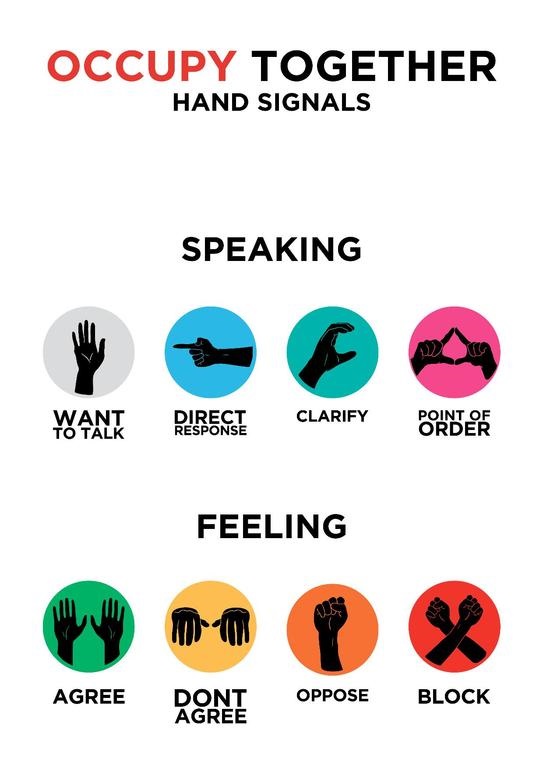
http://commons.wikimedia.org/wiki/File:OccupyHandSignals.pdf
   

|